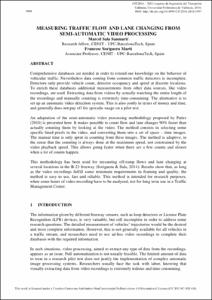Mostra el registre d'ítem simple
Measuring traffic flow and lane changing from semi-automatic video processing
| dc.contributor.author | Sala Sanmartí, Marcel |
| dc.contributor.author | Soriguera Martí, Francesc |
| dc.contributor.other | Universitat Politècnica de Catalunya. Departament d'Enginyeria Civil i Ambiental |
| dc.date.accessioned | 2016-11-09T16:31:07Z |
| dc.date.available | 2016-11-09T16:31:07Z |
| dc.date.issued | 2016 |
| dc.identifier.citation | Sala, M., Soriguera, F. Measuring traffic flow and lane changing from semi-automatic video processing. A: Congreso de Ingeniería del Transporte. "XII Congreso de Ingeniería del Transporte 7, 8 y 9 de junio Valencia (España): libro de actas/proceedings". Valencia: Universitat Politècnica de València, 2016, p. 1989-2000. |
| dc.identifier.isbn | 978-84-608-9960-0 |
| dc.identifier.uri | http://hdl.handle.net/2117/96441 |
| dc.description.abstract | Comprehensive databases are needed in order to extend our knowledge on the behavior of vehicular traffic. Nevertheless data coming from common traffic detectors is incomplete. Detectors only provide vehicle count, detector occupancy and speed at discrete locations. To enrich these databases additional measurements from other data sources, like video recordings, are used. Extracting data from videos by actually watching the entire length of the recordings and manually counting is extremely time-consuming. The alternative is to set up an automatic video detection system. This is also costly in terms of money and time, and generally does not pay off for sporadic usage on a pilot test. An adaptation of the semi-automatic video processing methodology proposed by Patire (2010) is presented here. It makes possible to count flow and lane changes 90% faster than actually counting them by looking at the video. The method consists in selecting some specific lined pixels in the video, and converting them into a set of space – time images. The manual time is only spent in counting from these images. The method is adaptive, in the sense that the counting is always done at the maximum speed, not constrained by the video playback speed. This allows going faster when there are a few counts and slower when a lot of counts happen. This methodology has been used for measuring off-ramp flows and lane changing at several locations in the B-23 freeway (Soriguera & Sala, 2014). Results show that, as long as the video recordings fulfill some minimum requirements in framing and quality, the method is easy to use, fast and reliable. This method is intended for research purposes, when some hours of video recording have to be analyzed, not for long term use in a Traffic Management Center. |
| dc.format.extent | 12 p. |
| dc.language.iso | eng |
| dc.publisher | Universitat Politècnica de València |
| dc.rights.uri | http://creativecommons.org/licenses/by-nc-nd/3.0/es/ |
| dc.subject | Àrees temàtiques de la UPC::Enginyeria civil::Infraestructures i modelització dels transports::Transport per carretera |
| dc.subject.lcsh | Traffic flow--Measurement |
| dc.title | Measuring traffic flow and lane changing from semi-automatic video processing |
| dc.type | Conference report |
| dc.subject.lemac | Circulació -- Intensitat -- Mesurament |
| dc.contributor.group | Universitat Politècnica de Catalunya. BIT - Barcelona Innovative Transportation |
| dc.relation.publisherversion | http://www.cit2016.es/libro_de_actas_cit2016.pdf |
| dc.rights.access | Open Access |
| local.identifier.drac | 19258830 |
| dc.description.version | Postprint (published version) |
| local.citation.author | Sala, M.; Soriguera, F. |
| local.citation.contributor | Congreso de Ingeniería del Transporte |
| local.citation.pubplace | Valencia |
| local.citation.publicationName | XII Congreso de Ingeniería del Transporte 7, 8 y 9 de junio Valencia (España): libro de actas/proceedings |
| local.citation.startingPage | 1989 |
| local.citation.endingPage | 2000 |


